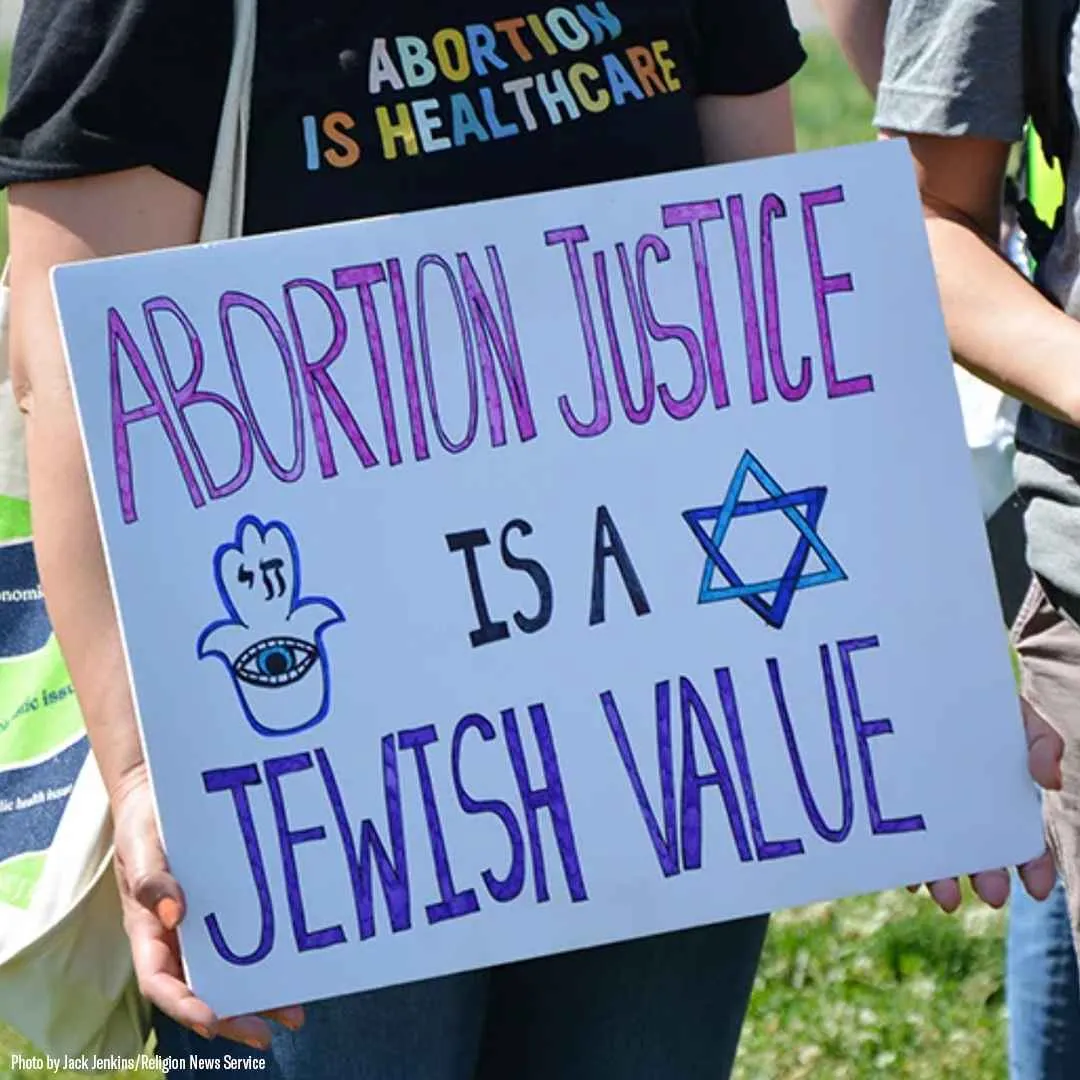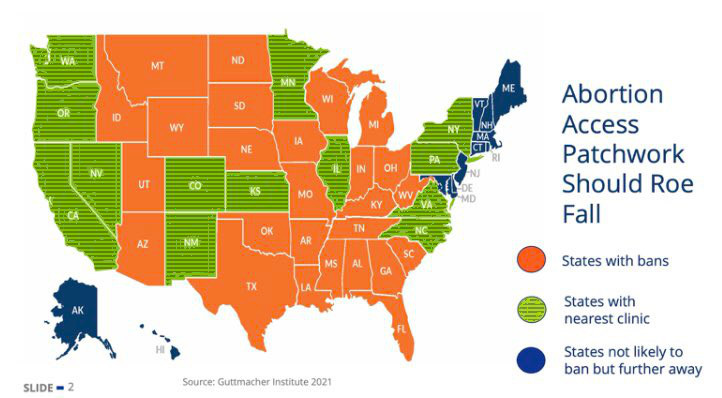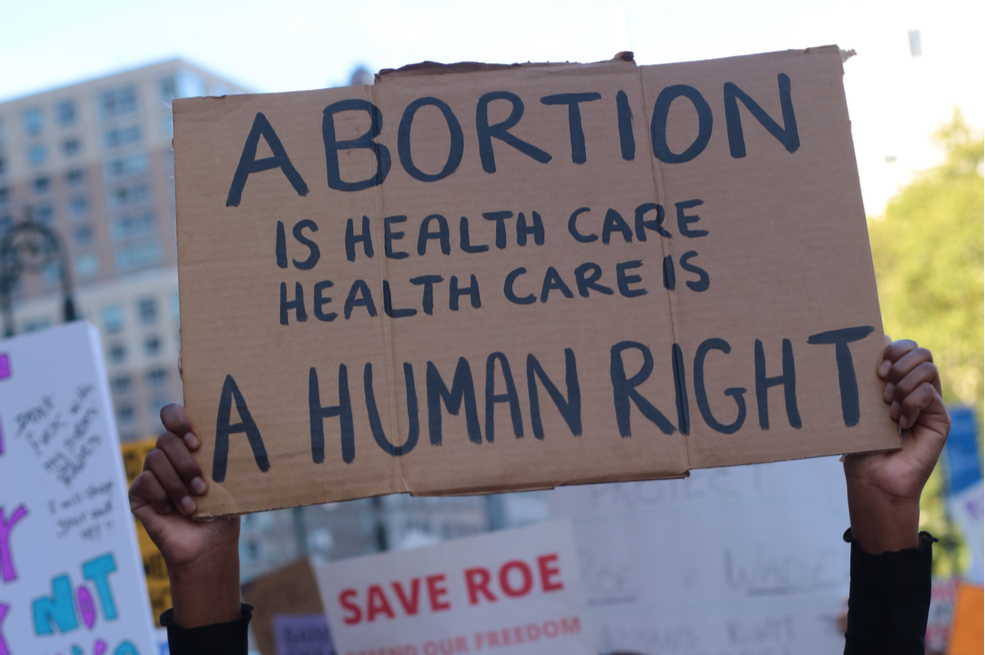The Torah of Reproductive Freedom
The Jewish Case for Abortion Justice

This is Life as a Sacred Text, an expansive, loving, everybody-celebrating, nobody-diminished, justice-centered voyage into one of the world’s most ancient and holy books. To subscribe, go here.
UPDATE, JUNE 28, 2022: This was written and published before the fall of Roe, on March 28th. I will not go through and update the whole framing up top, y’all will get to the text part in a second, but I will update so that resources at the bottom are up to date reflecting the work on the ground needed now.
So. Abortion access in the United States is in a “this is not a drill” situation right now.
SB8, the draconian 6-week abortion ban (effectively a total abortion ban, given that most people don’t know they’re pregnant at 6 weeks’ gestation) has been in place in Texas for over 6 months and SCOTUS has declined to block it three times.
Over 100 abortion bans were passed in 2021—the most in a single year since Roe v. Wade was decided in 1973, and 2022 is looking even more devastating for abortion rights and access—basically, states are working as hard as they can to move that Overton Window.
And perhaps most of all, the Supreme Court heard Dobbs v. Jackson Women’s Health on December 1st; the case will likely overturn or at least significantly gut Roe v. Wade. We’ll get the decision any time, now, most likely early summer.
If Roe falls, this map shows what things will look like the very next day based on laws these states already have on the books, cases tied up in courts, etc. Over half the country. It does not include states that might subsequently ban abortion, like Kansas or North Carolina.

OK, Rabbi, you’re thinking, this is a lot to take in, but I’m here for my NICE BIBLE NEWSLETTER and this is most decidedly NOT THAT.
Don’t worry. Religion content dropping in a sweet hot second.
One content note: These texts talk, unsurprisingly, about pregnant women. In the context of our contemporary gender categories, it might be useful to remember that, while many (but not all) cisgender women can get pregnant, so too can some non-binary people, some trans men, and some other people whose identities are not reflected in the framework of binary gender. Therefore today we should talk about “pregnant people,” “people who need abortions,” and “abortion access,” etc. and to remember that being more inclusive doesn’t erase anybody. After all, women are people!
So we were back in Exodus, eh?
When men fight, and one of them pushes a pregnant woman and a miscarriage results, but no other damage ensues, the one responsible shall be fined according as the woman’s husband may exact from him, the payment to be based on reckoning. But if other damage ensues, the penalty shall be life for life, eye for eye, tooth for tooth, hand for hand, foot for foot, burn for burn, wound for wound, bruise for bruise. (Exodus 21:22-25)
In other words, if someone accidentally causes a miscarriage to take place, they are obligated to pay financial damages only; the case is not treated as manslaughter. The “other damage” that would result in a more serious penalty would be the death of the pregnant person herself (or some other serious punishment relating to the damage caused—”eye for eye, tooth for tooth…”) In other words, causing the termination of a pregnancy is not, in the Torah, considered manslaughter. This, of course, has massive implications for the status of the fetus overall in Judaism, as we think about contemporary policy anti-abortion lingo like “personhood.” (That’s not a Jewish legal concept, NB.)
(The “eye for an eye” business is fascinating but tangental to what’s happening in today’s missive—don’t worry, we’ll unpack it another time.)
The Talmud spells this all out clearly (for Talmud-eze, but in a way that might be confusing to follow for those who don’t speak Talmud) on Sanhedrin 87b. This is the mainstream Jewish reading.
Interestingly, a mistranslation of this passage turned out to be kind of a Thing. In the Greek translation of the Hebrew Bible (known as the Septuagint, completed in 132 BCE), they translated ason, aka “damage” or “harm” in these Exodus verses, to exeikonismenon, “from the image,” making the verse seem to be about the stage of fetal development rather than whether or not the pregnant person dies. (“If a miscarriage results and it is not in the image/if, however, it is in the image...”)
That is, the question of whether one pays mere damages or incurs the death penalty could potentially appear to depend on whether the fetus is “formed,” or sufficiently developed in terms of gestational stages, to warrant a harsher punishment. Notably, the Septuagint translated the word ason in a different, more accurate, way (as malakia, affliction) in the Book of Genesis. There are a few theories as to why this happened, but it likely influenced Augustine’s theories about ensoulment—aka, the idea that the soul entered the fetus at a certain point in development.
Also interestingly, the King James Version (a favorite in Evangelical and other circles) chose “mischief” as the translation for “harm” or “damage.” Which, actually, was a decent translation in ca. 1600s English—but one can see how a reader today might not get the full picture of what was happening based on that word choice. (More on this whole translation question here.)

In any case, from there, we go into how Judaism thinks and talks about this stuff. Like, here’s the Talmud on the status of the fetus:
If she is found pregnant, until the fortieth day it is mere fluid. (Talmud Yevamot 69b)
That is to say, the fetus has no technical status for the forty days of pregnancy. It is like water—a thing of no legal significance. Was this because of the prevalence of miscarriages? Was it a larger philosophical claim? Regardless, this text is a clear assertion that life does not begin at conception. (Notably, Islam makes a similar claim.)
It may be worth noting that modern decisors of Jewish law count the 40 days as beginning from conception. Given that contemporary medical practice is to count pregnancy gestation from the last menstrual period—not conception—the end of those 40 days lands at about 7 or 8 weeks of pregnancy, by our current counting. It may also be worth noting that 66% of abortions happen within the first 8 weeks of pregnancy and that SB 8 in Texas (and the many copycat laws cropping up in various states)— bans abortion at 6 weeks.
What is the reason for Rabbi Yehuda HaNasi’s position [in a conversation that I’m not quoting because it’s irrelevant]? He holds that a fetus is considered as its mother’s thigh [that is, as part of the pregnant person’s body]. (Talmud Gittin 23b)
In the middle of a Talmudic debate about whether a fetus is considered separate from the pregnant person, we see a clear statement by Rabbi Yehuda HaNasi who, as redactor of the Mishnah, holds great authority. His statement, in fact, closes the debate and lends credence to the discussion at hand.
In Judaism, a fetus is not regarded as an independent being; it is part of the body of the person carrying it.
One in four people who can get pregnant will have an abortion by the age of 45. That includes people from every single community—including religious communities that claim that they Don’t Do That.
Now, a few sources on ending pregnancies. I’ll note that this first one is graphic, so I’m sharing a slightly edited version here; you can find the original version here.
If a woman is having trouble giving birth, they [terminate the pregnancy, even in early labor, in order to save her], because her life comes before the life of [the child]. But if the greater part has come out, one may not touch it, for one may not set aside one person's life for that of another. (Mishnah Oholot 7:6)
In a situation in which the pregnant person’s life is in danger from the pregnancy or labor, Jewish law is abundantly clear: The adult’s life takes precedence. That dynamic only starts to shift when the birth is already more than half completed (defined in later sources as when the head has emerged)--only then does the life of the baby come into consideration. As Rabbi David Felman put it,
“Implicit in [this] Mishnah is the teaching that the rights of the fetus are secondary to the rights of the mother all the way up until the moment of birth.”
This principle is cited elsewhere in the Talmud (Sanhedrin 72b), when the Rabbis assert that abortion to save the pregnant person’s life should be considered self-defense—that the fetus in this case is a rodef, a “pursuer” attempting to kill the pregnant person. Rashi, the important 11th century French commentator, says about this Mishnah above that “the entire time that that it has not gone out into the air of the world, it is not [considered] a life,” (Rashi on Sanhedrin 72b), likely referencing Genesis 2:7:
“Then God formed man of the dust of the ground, and breathed into his nostrils the breath of life; and man became a living soul.”
That is, these texts regard full life—rather than potential life—as taking place with the first breath.
When we think about abortion laws that enshrine a specific Christian (to be sure, not the only Christian) concepts—granting “fetal personhood” or asserting that life begins at conception—we begin, from here, to see how they are not only an infringement on the 14th Amendment (privacy) but that of the First Amendment. It tramples on a Jewish (and Muslim!) understanding of when life begins—to say nothing of the impacts for atheists, agnostics, and non-Christians of many different backgrounds, and Christians who regard things in other ways.
And you can already see how the reality for pregnant people in Texas flies in the face of these teachings, to say nothing of bills proposed in Ohio or Missouri that prioritize the doomed existence of an ectopic pregnancy over the life that could be saved by aborting it.
Abortion is not only permitted in Judaism (as you’ll see below) but it’s required in order to save the life of the pregnant person.
I wrote another piece on the Jewish case for abortion rights here.

Here are a few more recent texts that show some of the ways in which the texts above have been applied. The first, from 18th. c. Germany:
The questioner asks about an adulterous married woman (who is pregnant) is a good question. It appears to me to permit her (to abort)...And even in the case of a legitimate fetus there is reason to be lenient if there is a great need, as long as the fetus has not begun to emerge; even if the mother’s life is not in jeopardy, but only so as to save her from woe associated with it that would cause her great pain... (Rabbi Jacob Emden, Responsa She’elat Ya”vetz 1:43 (1739-1759, Germany))
Here, abortion is permitted in situations where carrying the fetus to term would cause "woe" and "great pain."
One might wonder if any situation in which one is forced to carry an unwanted pregnancy would not cause such things.
Another, from 18th c. Algeria:
I was asked and searched my heart/intellect to examine and explore what I had heard about a small group of women who become pregnant and do not want to give birth again, and who do not want to remain pregnant any more [once they had already conceived]. And some of these women…make a medication and drugs that are known to them to terminate a child, and he will become a nefel– a nonviable fetus…Behold– we have before us exactly what everyone acknowledges [is an acceptable situation where an abortion would be permitted], ..and [the mother] is permitted to drink an abortive drug, so it seems, according to my understanding of the issue. (Rabbi Yehudah ibn Ayyash of Algeirs, ‘She’eilot U’tshuvot’ Beit Yehudah, part “Even haEzer,” Siman 14, 1740.)
This above translation is by Rabbi Margaret Hughes-Robinson; you can find a full copy of the responsum here.
It should be noted that ibn Ayyash refers to scenarios in which what we would now both call "self-managed abortion" and "medication abortion," are taking place—and that he doesn’t say that husbands should be consulted, or that a rabbi should be called in to check specific cases, or anything of the sort. They’re handling it.
Medication abortion is one of the major areas that abortion access is and may continue to be available now, as bans and restrictions become more severe (June edit to add: and now that trigger bans are kicking in). They’re not a cure-all, but they’re useable for pregnancies up to 10 weeks, and there is increasing pressure to make them more available. (Tell Biden to direct the FDA to expand access!)
Spread the word about:
- PlanCPills.org - straight up medication abortion access
- AbortionOnDemand.org - physician supported/telehealth + medication abortion access
- AidAccess.org - I don’t know them personally but hearing they’re helpful esp in red states
OK, two more sources on all this. First, a major 20th c. Jewish medical ethicist suggests,
We see clearly that this permission of Rabbi Yaakov Emden is even when it is not a matter of saving the mother’s life, and it is only to save her from great pain because of the child, and that in general there is room to be lenient for great need. ...And suffering and emotional pain in great measure are greater and more painful than physical pain. (Rabbi Eliezer Waldenberg, Tzitz Eliezer 13:102 (1978))
There is room in the tradition to permit abortion in order to relieve someone who is pregnant from “great emotional pain.” And, again, one might speculate that any person who is forced to carry to term an unwanted pregnancy could, indeed, experience exactly that.
And the last, from another authoritative contemporary (d. 2015) Jewish legal voice:
Here it is clear that saving a life is not the only sanction for permitting an abortion.…It would seem to me that issues such as kevod ha-beriyot (dignity of persons), shalom bayit (domestic peace) and tza’ar (pain), which all carry significant [Jewish legal] weight in other contexts, should be considered in making these decisions. (Rabbi Aharon Lichtenstein, “Abortion: A Halakhic Perspective,” Tradition 25:4 (1991))
Again! Dignity! Pain! Suffering! Relationships! Woe! Emotional Pain! Rabbi Mordechai Winkler in 1919 (Levushei Mordekhai, Hoshen Mishpat 39) said that “Mental-health risk has been definitely equated with physical-health risk.” as a criteria!
Again, consider the impact of forced birthing laws on people’s lives, their safety, their mental health—their emotional pain, their woe.
People’s reasons for needing abortion care are valid.
And while I haven’t seen a Jewish legal source permitting abortion on the grounds of our commandments to pursue justice, we must remember that
abortion bans intensify every structural inequality in our society.
Those most impacted by them are people who are struggling financially; BIPOC (Black, Indigenous, and people of color) communities; young people; those in rural communities; immigrants; disabled people; and trans men and some nonbinary people.
People who are denied access to reproductive health care are more likely to live in poverty and to remain in abusive relationships as a result of that denied care.
A national abortion ban would also lead to a 21% rise in the number of overall pregnancy-related deaths — and a 33% rise in such deaths among Black women. This is because of systemic racism in health care and beyond—food deserts, unjust wages, mass incarceration, and more. (Of course, this does not mean that there are not many, many stories of safe, joyful birthing experiences, particularly when Black parents are supported in and by community. But we cannot pretend that abortion bans do not have dire and fatal consequences, nor that Black women, nonbinary people and trans men pay the highest price.)
We must not remain idle while barriers to health care place any individual’s health, well-being, autonomy, or economic security at risk.
This is the time to get involved. To be donating to abortion funds. To be showing up to actions. To spread the word about plancpills.org and aidaccess.org To sign up for JewsForAbortionAccess (more below.) To escort at your local clinic. To call your senators and tell them that they need to demand a legislative solution to the fall of Roe– and the harms of Hyde– now. To find your local reproductive justice organizations and ask how you can be of service. Giving up is not an option. there’s work to be done. There’s help that’s needed. All hands on deck, and there’s plenty of deck.
If not now, when?
HOW CAN YOU BE HELPFUL RIGHT NOW?
So, more on being useful, in this post-Roe dystopia to which I am still becoming accustomed, trying to make sense of.
1) Destigmatize abortion in your community.
It is a medical procedure that everyone should access. Offer care for those in your community who may need it now, whether or not they may need an abortion, whether or not they have had one (You know people who have had abortions. Everyone loves someone who’s had an abortion, as We Testify founder Renee Bracey Sherman puts it. Some abortion experiences are difficult, some liberating, some full of other emotions--don't presume).
2) If you want to help people who need help,
DONATE MONEY IF YOU HAVE IT to your local abortion fund. Find a local repro advocacy or justice org and ask if they need your capacity and particular skills. Maybe that means getting trained in practical support. Maybe, like, they’d be glad for a free website or help with data entry or your grantwriting skills or whatever. There are LOTS OF WAYS TO HELP and being arrested at a protest or helping someone get an abortion are NOT THE ONLY WAYS. Ahem.
3) Spread the word about medication abortion:
AbortionOnDemand.org , PlanCPills.org, AidAccess.org
As some of you might know, I was on Full Frontal with Samantha Bee with the amazing Rafa Kidvai of If/When/How and Jamie Manson of Catholics for Choice talking about some of this stuff:
Please share this one. This stuff is important, y’all. Again, this is not a drill. Lives and safety are at stake. Thanks for hearing.
And you can get more of this kind of thing in your inbox every week.
For FREE every Monday—sign up at the ‘Subscribe now’ button just below.
And you can get even more as part of a community of rabble rousers going deep into the questions and issues, with even more text and provocation, every Thursday.
And please know that nobody will ever be kept out due to lack of funds. Just email lifeisasacredtext@gmail.com for a hookup.
And if you’d like to underwrite one of these donated subscriptions, you can do so here.
And, again, please share this post—or at least some of the key links in it, above.
Sending a big pile of blessings and goodness your way.

